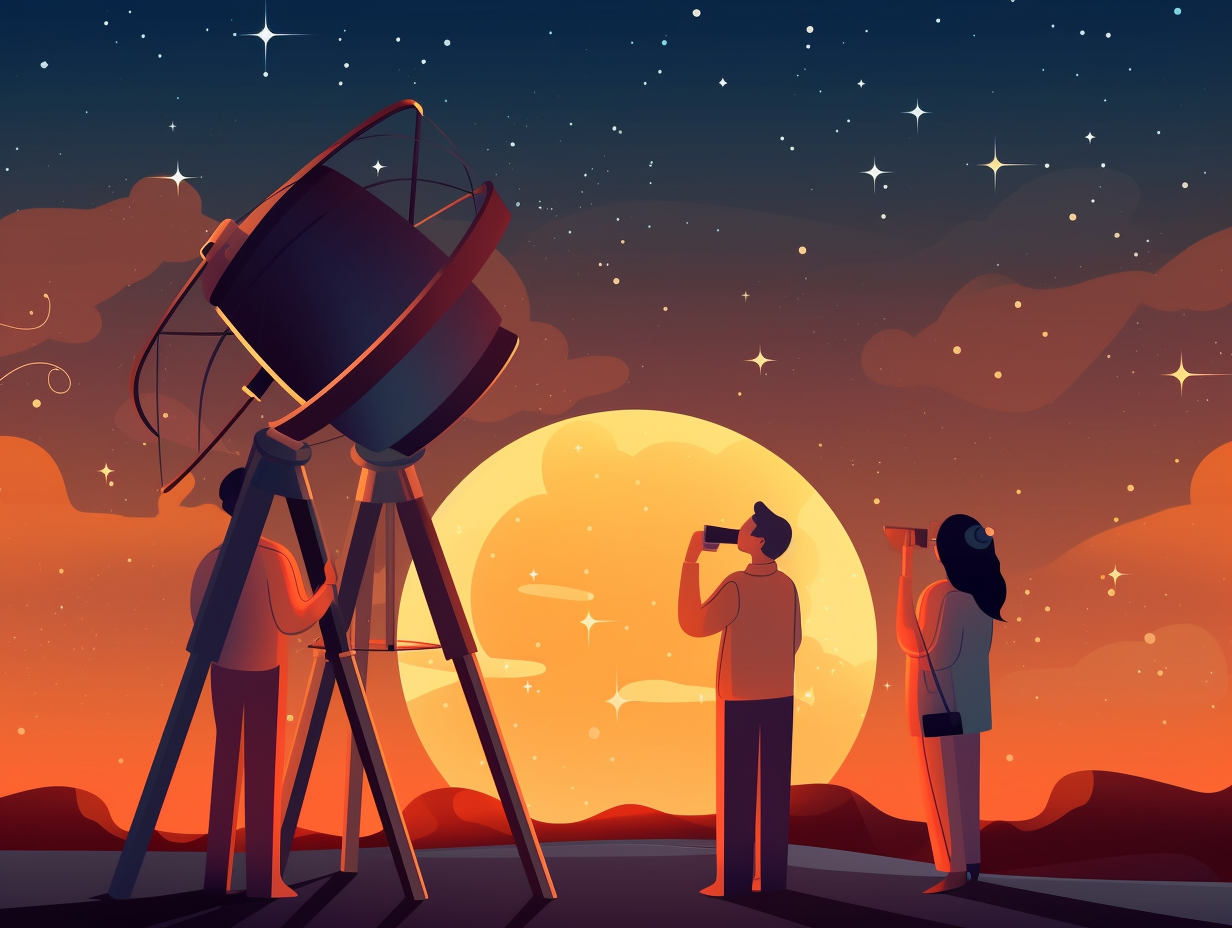Discover the Cosmos: Top 14 Exciting Fun Facts about the Mysterious Oort Cloud!

1. Cosmic Cocktail Mixologist
You might say the Oort Cloud is the Solar System's freezer, stuffed with a cosmic cocktail of icy treats like a mixologist's dream: This immense, theoretical cloud surrounding the Sun is made up of trillions of icy objects larger than 1 km, including frozen substances such as water, methane, and hydrogen cyanide, which occasionally find their way towards the inner Solar System as long-period comets jostled by the gravity of passing stars or the Milky Way galaxy.
Source => en.wikipedia.org
2. Surrounded by Icy Acquaintances
If you've ever felt lonely at a cosmic scale, have no fear – the Oort Cloud is here to remind us that we're positively surrounded by icy acquaintances: Extending up to 100,000 astronomical units away from the Sun, this vast cosmic cloud chillingly contains billions or even trillions of icy objects, making it home to more celestial pals than any app could ever help you discover.
Source => theplanets.org

Did you know the Kuiper Belt has its own cosmic party with diverse guests and 22 celestial couples dancing around each other in unique orbits? Discover more about this far-out shindig!
=> Fun Facts about The-Kuiper-Belt
3. Fashionable Hills Cloud
Step aside, outer space real estate moguls: The Oort Cloud may have some serious competition in the neighborhood watch. The lesser known, yet still fabulously mysterious and posh Hills Cloud has its sights set on being the next big thing in our Solar System's swanky comet community: First proposed by astronomer Jack G. Hills in 1981, the theoretical Hills Cloud is believed to exist within the Oort Cloud and could boast a whopping five times as many comets as its outer counterpart, making it the largest concentration of comets in the whole Solar System, all while maintaining a higher density than the Oort Cloud. Talk about outshining the competition!
Source => en.wikipedia.org
4. Exclusive Cosmic Concert
If the Oort cloud were a concert, it would be the coolest, most exclusive gig in the universe, with trillions of icy space groupies hanging around on the outskirts just waiting for their big moment to shine (and possibly crash a party near Earth): Located between 50,000 to 200,000 astronomical units from the Sun, this theoretical region is home to countless celestial objects, which are believed to be the source of long-period comets that occasionally visit the inner Solar System, like guests who get a once-in-a-lifetime backstage pass.
Source => en.wikipedia.org

5. Colossal, Icy Neighbor
If asteroids are the solar system's grumpy old pebbles, the Oort Cloud is their colossal, icy neighbor who casually hoards treasures unseen: In this mysterious region, trillions of icy objects dwell, some measuring up to 200 kilometers in diameter - larger than most common asteroids, but they remain elusive to direct observation due to their immense distance from the Sun.
Source => lco.global
6. Solar System's Ice Cube Tray
The Solar System's far-out walk-in freezer of cosmic ice cubes: The Oort Cloud is estimated to house trillions of icy objects, some boasting diameters of over 1 kilometer! This chilly celestial collection not only kick-starts long-period comets that tumble into the Solar System, but also harbors a torus-shaped inner region - the Hills Cloud - which may contain tens or hundreds of times more cometary nuclei.
Source => en.wikipedia.org
7. Chilly Cloud Pet Adoption
Looking to adopt a chilly, ethereal cloud pet with trillions of icy critters? Head to the Oort Cloud: An astonishing astronomical locale believed to house a myriad of freezing objects including long-period and Halley-type comets in our Solar System. Spanning up to 50,000 AU from the Sun, the vast majority of these satellite-sized residents are composed of water, methane, and nitrogen. Be mindful, though – the Oort Cloud's great distance makes it susceptible to the gravitational whims of passing stars and the Milky Way, hurling resident comets towards the inner Solar System.
Source => en.wikipedia.org
8. Slipper Thief? Nope, Comet Sender!
Searching for the culprit behind your missing fuzzy slippers? Sorry to burst your bubble, but the Oort Cloud isn't your guy: However, this mysterious band of icy objects orbiting our solar system is responsible for sending long-period comets into our inner celestial neighborhood, all thanks to some cosmic meddling from nearby stars and interstellar molecular clouds.
Source => sciencedirect.com
9. Cosmic Hide-and-Seek Champion
Behold the Oort Cloud, the mystical hide-and-seek champion of the cosmos: This elusive cosmic entity evades direct observation but makes its cosmic presence known through the orbits of long-period comets, the Oort spike, and how the galactic tide and planetary perturbations play peekaboo with our observable comets from the inner to the outer Oort Cloud.
Source => onlinelibrary.wiley.com

10. Birthplace of Cosmic Rockstars
Did you hear about the Sun's frosty entourage, the Oort Cloud? The rumors say it's the birthplace of cosmic rockstars flying through the sky with streaks of icy glamour; truly a VIP entrance for comets in the inner Solar System: The Oort Cloud, a hypothetical region of space, is believed to be the origin of most long-period and Halley-type comets, as well as numerous other heavenly bodies. While unconfirmed, this cloud of icy planetesimals may have been flung far into the cosmic abyss by early gravitation interaction with the giant planets, and nudged back into the limelight by passing stars and the Milky Way's influence.
Source => en.wikipedia.org
11. Icy Disco Ball of Debris
Picture this: a cosmic disco ball made of ice and ancient space dust, shivering its way around our solar neighborhood, occasionally sending a celestial party crasher to visit us in the form of a comet. That's the Oort Cloud for you! The serious reveal: this gargantuan, spherical cloud of debris, over one light-year from the Sun, is the birthplace of long-period comets that can take thousands or even millions of years to orbit, setting it apart from the short-period comets hailing from the Kuiper Belt.
Source => sciencedirect.com
12. Oort Cloud's Family Reunion
If you think your distant relatives are far away, wait till you hear about the Oort Cloud's family reunion: The Oort Cloud is a colossal collection of icy space debris that encircles our Solar System at a whopping 100,000 astronomical units away from the Sun, making the distance to Pluto and the Kuiper Belt look like a jaunt to the corner store. This icy congregation is considered the birthplace of long-period comets, with some taking millions of years to orbit the Sun before they finally get to RSVP to the solar party.
Source => bbc.com
13. Cosmic Block Party Crashers
If you think your neighborhood is crowded, you should check out the ultimate cosmic block party: The Oort Cloud, located over 1000 AU from the Sun, is home to an estimated trillion icy and rocky party crashers! But what happens when the real stars (passing by within 1 pc) show up? They cause a small fraction of comets on the outskirts of the Oort Cloud to go rogue and transform into "transitional interstellar comets" (TICs). With their semi-major axis raised to interstellar distances, these TICs might just become the next big thing - as interstellar objects!
Source => aanda.org
14. Celestial Uber to Oort Cloud
Don't expect to catch a ride to the Oort Cloud with your average celestial Uber: this outer space destination is so remote that it demands interstellar travel technology just to reach its icy doorstep. A mysterious shell of water, methane, and other frosty bodies: the Oort Cloud is home to trillions of objects, far beyond the sun's magnetic grasp, and gives birth to many long-period comets, making it the chilliest, most elusive hangout in our cosmic neighborhood.
Source => space.com
Related Fun Facts




















